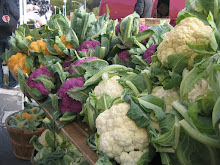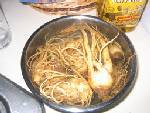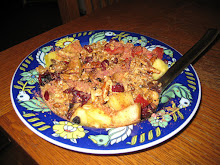It's people's birthdays and I am short on cash and time to go out and shop. What do I do? I bake some cookies. Smitten Kitchen has an amazing recipe for oat, chocolate chip, and pecan cookies that includes orange zest, but I needed to pare down the extravagance so I adapted it a little bit. They are addictive: crispy all around, chewy in the center, and salty-sweet. Definitely a keeper.
Sweet & Salty Chocolate Chip Oat Walnut Cookies
8 tablespoons unsalted butter, at room temperature
3/4 cup sugar (half white sugar, half turbinado)
1 cup light brown sugar, firmly packed
1 1/2 teaspoon coarse sea salt
1 1/2 teaspoon vanilla extract
2 large eggs
1 1/2 cups flour
1 teaspoon baking soda
1/2 teaspoon ground cinnamon
1/4 teaspoon ground nutmeg
1 cup oats
1 cup chopped walnuts
3 tsp grated coconut (optional)
12 ounces semisweet chocolate chips
Preheat oven to 350°F.
Whip the butter in a large mixing bowl and then add the sugars, salt, and vanilla,
and beat until well mixed, about three minutes. Stir in eggs, one at a
time. Sift together the flour, baking soda, cinnamon and nutmeg
in a separate bowl. Carefully mix the flour into the butter mixture a bit at a time, and then stir in the oats, walnuts, chocolate chips, and coconut if you like.
Using a small cookie scoop, plop the dough onto a greased cookie sheet 2" apart and bake for 8 to 10 minutes or until golden. Remove from the oven and cool the
cookies on a rack. Store at room temperature in a cookie jar or other
airtight container.
Tuesday, September 24, 2013
Monday, September 9, 2013
Bringing the Streets of Jerusalem Home
"Sabih" is the name of this dish from the Tamami & Ottolenghi cookbook Jerusalem. It's roots are Iraqi, but it has elements from many Middle Eastern traditions. One thing is for sure--it's delicious.
I adapted the Jerusalem recipe somewhat, and I think it turned out really well.
Sabih
2 medium-sized eggplants
4 plum tomatoes
2 medium orange tomatoes
2 kirby cucumbers (or one large cuke)
handful of parsley
3 green onions/scallions
3 hardboiled eggs
2 tbsp s'chug or zhoug
1 cup tahini
1 cup yogurt
1 tbsp lemon juice
salt, pepper, olive oil
harissa (if the zhoug isn't hot enough for ya)
pomegranate seeds (optional)
quality pitas (3-4)
Slice the eggplant in half and place the halves, innards up, in a baking dish. Spray with olive oil and season with salt and pepper. I added a little bit of ras-al-hanout, but you could also season with paprika or sumac. Roast in an oven at 375 degrees F until the eggplant is tender, but not mushy. Allow to cool. The Jerusalem cookbook wants you to fry the eggplant; I guess that's traditional, but I needed to bake mine.
Hardboil your eggs (best method here) and begin to make the salad by cubing tomatoes & cucumbers and mixing them with good olive oil, chopped scallions, chopped parsley, and salt & pepper. Allow to rest and marinate for 1/2 an hour to an hour.
Make the tahini sauce by combining tahini, yogurt, and lemon juice and a little bit of salt. This mixture should be thin enough to pour, but not watery.
When the eggplant has cooled, peel the skin and roughly chop the eggplant into cubes. Mix the cubes with the s'chug to taste. The Jerusalem cookbook calls it zhoug, which is typical in a bunch of different cuisines. If you pinpoint it, it might be Yemeni. And you can make it from scratch. Mine is from Sabra, yes, of Sabra hummus. I've had this s'chug in the fridge for about a year--I have no idea why I bought it, but it is GOOD. It's existence in the bottom of the fridge is one of the reasons I chose this recipe. Remember, the s'chug is really hot. And if you want the taste of harissa, too, either eliminate or drastically reduce the s'chug.
Toast the pitas in a warm oven until puffy. You can help this along by spraying a bit of olive oil on the pitas. (Unfortunately, we passed up some fresh-made pitas at the bakery today because we had some in a bag in the fridge. This recipe deserves the best pita possible. Just sayin').
On the toasted pitas, begin assembling by pouring a few dollops of tahini sauce on the warm pitas. Place a few spoonfuls of eggplant on each pita, then layer on the slices of hardboiled egg. Top with a bit more tahini sauce, top with the salad, then place some more tahini sauce on top of that. Garnish with some pomegranate seeds.
I don't know how you eat this thing. I guess on the street in Jerusalem you'd get it in a more user-friendly pita wrapped in wax paper and it would be all rolled up. On our plates, we cut the pitas in quarters and ate it greedily with our hands.
You can get most of these ingredients at Sahadi's if you live in Brooklyn (but they also ship now, too), or maybe at Kalustyan's in Manhattan. But mostly everything you can make from scratch--except the tahini.
I adapted the Jerusalem recipe somewhat, and I think it turned out really well.
Sabih
2 medium-sized eggplants
4 plum tomatoes
2 medium orange tomatoes
2 kirby cucumbers (or one large cuke)
handful of parsley
3 green onions/scallions
3 hardboiled eggs
2 tbsp s'chug or zhoug
1 cup tahini
1 cup yogurt
1 tbsp lemon juice
salt, pepper, olive oil
harissa (if the zhoug isn't hot enough for ya)
pomegranate seeds (optional)
quality pitas (3-4)
Slice the eggplant in half and place the halves, innards up, in a baking dish. Spray with olive oil and season with salt and pepper. I added a little bit of ras-al-hanout, but you could also season with paprika or sumac. Roast in an oven at 375 degrees F until the eggplant is tender, but not mushy. Allow to cool. The Jerusalem cookbook wants you to fry the eggplant; I guess that's traditional, but I needed to bake mine.
Hardboil your eggs (best method here) and begin to make the salad by cubing tomatoes & cucumbers and mixing them with good olive oil, chopped scallions, chopped parsley, and salt & pepper. Allow to rest and marinate for 1/2 an hour to an hour.
Make the tahini sauce by combining tahini, yogurt, and lemon juice and a little bit of salt. This mixture should be thin enough to pour, but not watery.
When the eggplant has cooled, peel the skin and roughly chop the eggplant into cubes. Mix the cubes with the s'chug to taste. The Jerusalem cookbook calls it zhoug, which is typical in a bunch of different cuisines. If you pinpoint it, it might be Yemeni. And you can make it from scratch. Mine is from Sabra, yes, of Sabra hummus. I've had this s'chug in the fridge for about a year--I have no idea why I bought it, but it is GOOD. It's existence in the bottom of the fridge is one of the reasons I chose this recipe. Remember, the s'chug is really hot. And if you want the taste of harissa, too, either eliminate or drastically reduce the s'chug.
Toast the pitas in a warm oven until puffy. You can help this along by spraying a bit of olive oil on the pitas. (Unfortunately, we passed up some fresh-made pitas at the bakery today because we had some in a bag in the fridge. This recipe deserves the best pita possible. Just sayin').
On the toasted pitas, begin assembling by pouring a few dollops of tahini sauce on the warm pitas. Place a few spoonfuls of eggplant on each pita, then layer on the slices of hardboiled egg. Top with a bit more tahini sauce, top with the salad, then place some more tahini sauce on top of that. Garnish with some pomegranate seeds.
I don't know how you eat this thing. I guess on the street in Jerusalem you'd get it in a more user-friendly pita wrapped in wax paper and it would be all rolled up. On our plates, we cut the pitas in quarters and ate it greedily with our hands.
You can get most of these ingredients at Sahadi's if you live in Brooklyn (but they also ship now, too), or maybe at Kalustyan's in Manhattan. But mostly everything you can make from scratch--except the tahini.
Sunday, September 8, 2013
Attica!!!
We just finished watching Orange is the New Black the other day. Once you get past being angry at Piper's privilege and what you think is going to be some ridiculous racial stereotypes about women in prison, the show is really very good. And it highlights some of the most messed up things about prison life in a way that no other popular show has for a mass audience.
I was psyched to see them deal with solitary confinement (or extreme isolation) in one episode. One of the punishments used in solitary is to feed prisoners "the loaf" (or "nutraloaf" as it's sometimes called) -- a horrible slice of tasteless flour and scraps that barely provides any nutrition whatsoever. (This is Piper confronting "the loaf" for the first time).
My blogs are usually about tasty foods, but I thought this might be a good occasion to depart from the norm and talk about this distinctively unsavory dish.
Tomorrow (September 9th) is the 42nd anniversary of the Attica prison riots, and I thought it might be a good occasion to re-post a blog entry from a colleague in the New York State Legislature: Dianna Goodwin, who engages in some participatory advocacy by providing us with a recipe for the loaf, and making some herself. Thanks, Dianna. She also provides a helpful summary of what the Attica rebellion was all about. Read it (and weep) here.
It's time to end extreme isolation -- in New York State and everywhere else. My colleagues at the American Civil Liberties Union and the New York Civil Liberties Union worked to limit the use of solitary confinement for immigrants, and were successful in their endeavors this week. (Read about that here). But there's more work to do. You can read NYCLU's report about the use of extreme isolation in New York State here. Food punishment like serving prisoners "the loaf" is a barbaric and harmful practice--and this is just one type of punishment prisoners endure. It must end. Join the campaign to end the practice of extreme isolation today.
I was psyched to see them deal with solitary confinement (or extreme isolation) in one episode. One of the punishments used in solitary is to feed prisoners "the loaf" (or "nutraloaf" as it's sometimes called) -- a horrible slice of tasteless flour and scraps that barely provides any nutrition whatsoever. (This is Piper confronting "the loaf" for the first time).
My blogs are usually about tasty foods, but I thought this might be a good occasion to depart from the norm and talk about this distinctively unsavory dish.
Tomorrow (September 9th) is the 42nd anniversary of the Attica prison riots, and I thought it might be a good occasion to re-post a blog entry from a colleague in the New York State Legislature: Dianna Goodwin, who engages in some participatory advocacy by providing us with a recipe for the loaf, and making some herself. Thanks, Dianna. She also provides a helpful summary of what the Attica rebellion was all about. Read it (and weep) here.
It's time to end extreme isolation -- in New York State and everywhere else. My colleagues at the American Civil Liberties Union and the New York Civil Liberties Union worked to limit the use of solitary confinement for immigrants, and were successful in their endeavors this week. (Read about that here). But there's more work to do. You can read NYCLU's report about the use of extreme isolation in New York State here. Food punishment like serving prisoners "the loaf" is a barbaric and harmful practice--and this is just one type of punishment prisoners endure. It must end. Join the campaign to end the practice of extreme isolation today.
Sunday, September 1, 2013
Kuri Curry
This beautiful red kuri squash (or Japanese hokkaido) that I found at the Albany food co-op was too tempting to pass up, even though in the heat of summer, roasting squash is not at the top of my list of things to do. I roasted the squash by cutting it in half, scooping out the seeds, and coating with olive oil, salt, and pepper, and placing it face-down on a baking sheet at 350 degrees. When soft, I took the halves out of the oven, let them cool, and then froze them to make soup another day.
Roasted Red Kuri Coconut Curry Soup
1 teardrop-shaped red kuri squash
4 tbsp olive oil
salt & pepper
4 cloves of garlic
1 medium red onion
1 tbsp fresh grated ginger, diced
1 tbsp tomato paste
1 -2 tbsp thai red curry paste
One 13.5 oz can of coconut milk
4 cups of broth (veggie, chicken, or thai curry)
1 1/2 tsp salt
Once your red kuri is roasted, cut into more manageable pieces for sauteing. You can use the skin, it's so tender. Heat 2 tbsp of olive oil in a wok and when hot, add the diced garlic, onion, and ginger. Saute until golden and then add the red kuri squash. Saute the mixture until it begins to brown, and then add the tomato paste, curry paste, coconut milk, broth and salt. Mix to combine while simmering over medium heat. Cook for about 20 minutes and then let cool a bit before pureeing in a blender. There's all kinds of ways to garnish this, but I'll try some yogurt, curry powder, and maybe some pepitas. You can also garnish with fresh herbs--maybe basil or mint.
Roasted Red Kuri Coconut Curry Soup
1 teardrop-shaped red kuri squash
4 tbsp olive oil
salt & pepper
4 cloves of garlic
1 medium red onion
1 tbsp fresh grated ginger, diced
1 tbsp tomato paste
1 -2 tbsp thai red curry paste
One 13.5 oz can of coconut milk
4 cups of broth (veggie, chicken, or thai curry)
1 1/2 tsp salt
Once your red kuri is roasted, cut into more manageable pieces for sauteing. You can use the skin, it's so tender. Heat 2 tbsp of olive oil in a wok and when hot, add the diced garlic, onion, and ginger. Saute until golden and then add the red kuri squash. Saute the mixture until it begins to brown, and then add the tomato paste, curry paste, coconut milk, broth and salt. Mix to combine while simmering over medium heat. Cook for about 20 minutes and then let cool a bit before pureeing in a blender. There's all kinds of ways to garnish this, but I'll try some yogurt, curry powder, and maybe some pepitas. You can also garnish with fresh herbs--maybe basil or mint.
Subscribe to:
Comments (Atom)




















